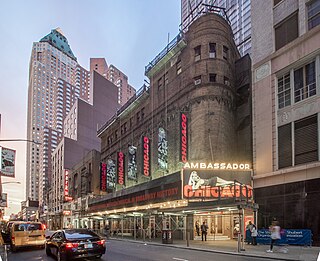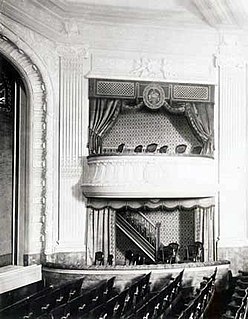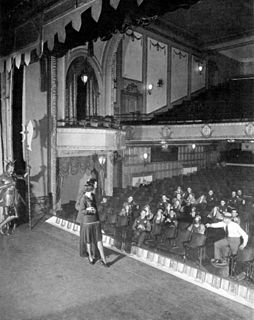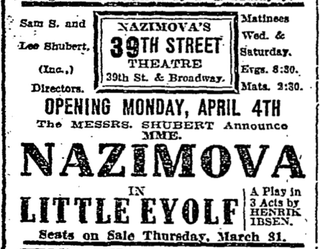
The Winter Garden Theatre is a Broadway theatre at 1634 Broadway in the Midtown Manhattan neighborhood of New York City. It opened in 1911 under designs by architect William Albert Swasey. The Winter Garden's current design dates to 1922, when it was completely remodeled by Herbert J. Krapp. Due to the size of its auditorium, stage, and backstage facilities, it is favored for large musical productions. It has 1,600 seats and is operated by The Shubert Organization. The auditorium interior is a New York City landmark.
The Shubert family was responsible for the establishment of the Broadway district, in New York City, as the hub of the theatre industry in the United States. They dominated the legitimate theater in vaudeville in the first half of the 20th century, promoting entertainment attuned to the popular taste.
The Adelphi Theatre, originally named the Craig Theatre, opened on December 24, 1928. The Adelphi was located at 152 West 54th Street in Manhattan, with 1,434 seats. The theater was taken over by the Federal Theater Project in 1934 and renamed the Adelphi. The theater was renamed the Radiant Center by The Royal Fraternity of Master Metaphysicians in 1940. It was then the Yiddish Arts Theater (1943), and renamed the Adelphi Theater on April 20, 1944, when it was acquired by The Shubert Organization. Some interiors were decorated with murals painted by Joseph Mortimer Lichtenauer. The artistic cycle was dismembered after its demolition.

The Shubert Theatre is a Broadway theater at 225 West 44th Street in the Theater District of Midtown Manhattan in New York City. Opened in 1913, the theater was designed by Henry Beaumont Herts in the Italian Renaissance style and was built for the Shubert brothers. Lee and J. J. Shubert had named the theater in memory of their brother Sam S. Shubert, who died in an accident several years before the theater's opening. It has 1,502 seats across three levels and is operated by The Shubert Organization. The facade and interior are New York City landmarks.

The Broadway Theatre is a Broadway theater at 1681 Broadway in the Theater District of Midtown Manhattan in New York City. Opened in 1924, the theater was designed by Eugene De Rosa for Benjamin S. Moss, who originally operated the venue as a movie theater. It has approximately 1,763 seats across two levels and is operated by The Shubert Organization. The Broadway Theatre is one of the few Broadway theaters that is physically on Broadway.

The Gerald Schoenfeld Theatre, formerly the Plymouth Theatre, is a Broadway theater at 236 West 45th Street in the Theater District of Midtown Manhattan in New York City. Opened in 1917, the theater was designed by Herbert J. Krapp and was built for the Shubert brothers. The Schoenfeld Theatre is named for Gerald Schoenfeld, longtime president of the Shubert Organization, which operates the theater. It has 1,079 seats across two levels. Both the facade and the auditorium interior are New York City landmarks.

The Broadhurst Theatre is a Broadway theater at 235 West 44th Street in the Theater District of Midtown Manhattan in New York City. Opened in 1917, the theater was designed by Herbert J. Krapp and was built for the Shubert brothers. The Broadhurst Theatre is named for British-American theatrical producer George Broadhurst, who leased the theater before its opening. It has 1,218 seats across two levels and is operated by The Shubert Organization. Both the facade and the auditorium interior are New York City landmarks.

The Booth Theatre is a Broadway theater at 222 West 45th Street in the Theater District of Midtown Manhattan in New York City. Opened in 1913, the theater was designed by Henry Beaumont Herts in the Italian Renaissance style and was built for the Shubert brothers. The venue was originally operated by Winthrop Ames, who named it for 19th-century American actor Edwin Booth. It has 800 seats across two levels and is operated by The Shubert Organization. The facade and parts of the interior are New York City landmarks.

The Ambassador Theatre is a Broadway theater at 219 West 49th Street in the Theater District of Midtown Manhattan in New York City. Opened in 1921, the Ambassador Theatre was designed by Herbert J. Krapp and was constructed for the Shubert brothers. It has 1,125 seats across two levels and is operated by The Shubert Organization. The auditorium interior is a New York City designated landmark.

The Princess Theatre was a joint venture between the Shubert Brothers, producer Ray Comstock, theatrical agent Elisabeth Marbury and actor-director Holbrook Blinn. Built on a narrow slice of land located at 104–106 West 39th Street, just off Sixth Avenue in New York City, and seating just 299 people, it was one of the smallest Broadway theatres when it opened in early 1913. The architect was William A. Swasey, who designed the Winter Garden Theatre two years earlier.

The Casino Theatre was a Broadway theatre located at 1404 Broadway and West 39th Street in New York City. Built in 1882, it was a leading presenter of mostly musicals and operettas until it closed in 1930.

The Vanderbilt Theatre was a New York City Broadway theatre, designed by architect Eugene De Rosa for producer Lyle Andrews. It opened in 1918, located at 148 West 48th Street. The theatre was demolished in 1954.

The Majestic Theatre was a theatre located at 5 Columbus Circle, the present site of the Time Warner Center in Manhattan, New York City.

Shubert Alley is a pedestrian alley in the Theater District of Midtown Manhattan in New York City. The alley, a privately owned public space, connects 44th and 45th Streets and covers about 6,400 square feet (590 m2). It runs through the middle of a city block, parallel to Eighth Avenue to the west and Broadway to the east. The western half of the alley abuts the Shubert and Booth theaters, while the eastern half is adjacent to One Astor Plaza. Because it is near several major theaters, the alley has been considered the geographical center of Broadway theatre.
Jesse C. Huffman (1869–1935) was an American theatrical director. Between 1906 and 1932 he directed or staged over 200 shows, mostly for the Shubert Brothers. Many of them were musical revues, musicals or operettas. He is known for The Passing Show series of revues that he staged from 1914 to 1924 at the Winter Garden Theatre on Broadway, daring alternatives to the Ziegfeld Follies.
The Colonial Theatre in New York City was at Broadway and 62nd Street in what was then the San Juan Hill neighborhood on the Upper West Side, Manhattan. Originally named the Colonial Music Hall, it was opened in 1905 by Frederic Thompson and Elmer "Skip" Dundy. Designed by George Keister, the theater had a seating capacity of 1,293.

Daly's Theatre was a Broadway theatre at 1221 Broadway and 30th Street. It was built in 1867 and opened that year as Banvard's Museum but changed its name the following year to Wood's Museum and Metropolitan. In 1876 it became the Broadway Theatre, and finally was named Daly's Theatre in 1879 when it was acquired by Augustin Daly. After 1899, it was operated by the Shubert family. The building was demolished in 1920, after serving as a burlesque theatre and cinema.

The 39th Street Theatre was a playhouse in New York City located at the corner of 39th Street and Broadway. Originally called Nazimova's 39th Street Theatre after the actress Alla Nazimova, it was in operation from 1910 to 1925 when it was demolished to make way for an office building. Throughout its existence, it was owned by the Shubert family. Its architect was William Albert Swasey, who had designed or remodelled several other Broadway theatres for the family.

The Sam H. Harris Theatre was a Broadway theatre within the Candler Building, at 226 West 42nd Street, in the Theater District of Manhattan in New York City. It was built in 1914 and stopped producing plays in 1933. It remained in operation as a movie house for decades and was demolished in 1996.
Nancy McCord was an American soprano and actress who had an active career in opera, musical theatre, and vaudeville during the 1920s, 1930s and early 1940s. She appeared in operettas and musicals on Broadway and in operas with several American companies, including the St. Louis Municipal Opera and the Metropolitan Opera. Her repertoire consisted mainly of roles from light opera and operettas. She is best remembered for creating the roles of Marie-Baroness von Schlewitz in the original production of Oscar Hammerstein II and Sigmund Romberg's May Wine (1935); and Mary Stone in the world premiere of Douglas Moore's The Devil and Daniel Webster (1939). She also performed leading roles in the United States premieres of two operettas: Franz Lehár's The Land of Smiles and Robert Stolz's Venus in Seide.















